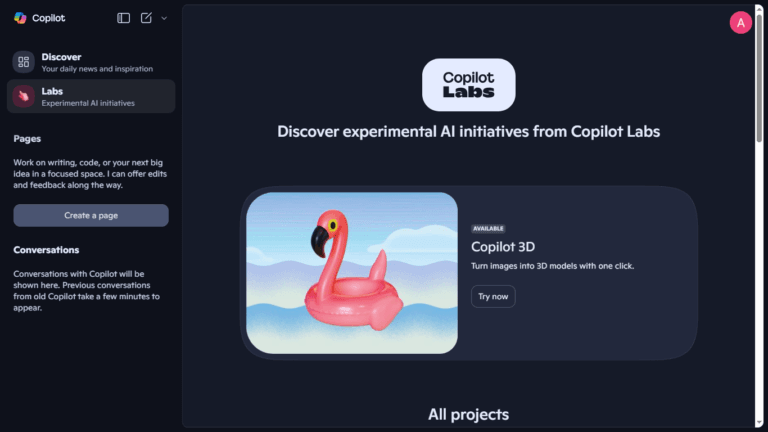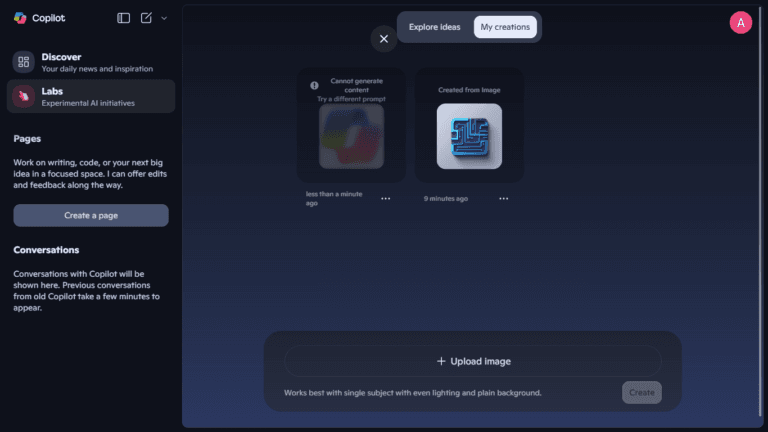
Summary
Microsoft has launched Copilot 3D, an AI-powered tool in Copilot Labs that converts 2D PNG or JPG images into 3D models in seconds. Designed for rapid prototyping, concept testing, and education, it allows users to upload images up to 10MB and export results in GLB format for use in AR apps, game engines, and design tools. Best suited for simple objects like furniture, Copilot 3D is free for select users, stores creations for 28 days, and ensures privacy by not using user-generated models for AI training. This release follows the debut of GPT-5-powered Smart Mode, highlighting Microsoft’s push to integrate AI into creative workflows.
Table of Contents
Introduction
Microsoft has just taken another major leap in its artificial intelligence (AI) journey with the introduction of Copilot 3D — a groundbreaking tool capable of transforming ordinary 2D images into fully functional 3D models within seconds.
The announcement came just one day after Microsoft rolled out GPT-5-powered Smart Mode in Copilot, signaling the tech giant’s intensified push to blend AI into creative and design workflows. This move could reshape how designers, game developers, educators, and hobbyists create 3D content.
What is Microsoft Copilot 3D?
According to Microsoft’s product description, Copilot 3D is part of Copilot Labs — an experimental space for testing AI-powered creative tools. Its goal is simple but powerful: make 3D creation “fast, accessible, and intuitive” for everyone.
Unlike traditional 3D modeling software that often demands technical expertise and hours of manual work, Copilot 3D produces results in seconds. Currently, the feature is free for a subset of users and requires sign-in via a Microsoft or Google account.
In its official documentation, Microsoft notes that the tool is designed for:
Rapid prototyping
Concept testing
Educational use
These are scenarios where speed and accessibility matter more than ultra-detailed modeling, making Copilot 3D ideal for quick visualizations.
How Copilot 3D Works
The workflow is refreshingly straightforward. Users can upload any PNG or JPG image under 10MB, hit the “Create” button, and let the AI handle the transformation.
In a matter of seconds to a minute, the system generates a 3D model that can be exported in GLB format — a widely supported 3D file type compatible with major 3D viewers, tools, and game engines like Unity and Unreal Engine.
Step-by-step usage guide:
Visit Copilot.com using a desktop browser.
Click the sidebar button at the top left.
Navigate to “Labs” and select “Try Now” under Copilot 3D.
Upload your PNG or JPG image (≤10MB).
Click “Create” and wait for the 3D model to generate.
Download or export your model from the “My Creations” page.
The “My Creations” page stores your models for 28 days, giving you time to download and manage them before they’re removed from Microsoft’s servers. These models can also be exported for augmented reality (AR) applications, adding another layer of interactivity.
Here Is My Demo Using favicon Image of techmitra.in
Here Is a Video :
Performance and Best Results
Early testing by The Verge suggests that Copilot 3D performs exceptionally well with furniture and common objects like chairs, umbrellas, and fruit. However, it may have difficulty with animals, people, or objects with intricate details.
To maximize quality, Microsoft recommends:
Using images with clear subject-background separation.
Ensuring high contrast between the object and its surroundings.
Avoiding cluttered or overly complex scenes.
While it currently only supports PNG and JPG, Microsoft may expand file format compatibility and size limits in future updates.
To evaluate Copilot 3D’s capabilities, we tested it with two different images — the official Copilot icon and a human face photograph. The results were mixed. The Copilot icon image failed to process and returned an error message. The human face image did generate, but the 3D output was heavily distorted, with the face losing its recognizable shape and becoming almost unidentifiable.
This aligns with Microsoft’s own note that the tool performs best with simple, clearly defined objects and may struggle with complex organic shapes like human faces.

Limitations to Keep in Mind
Like any early-stage AI tool, Copilot 3D has its constraints:
File Size Limit: Max 10MB per image.
File Formats: Only PNG and JPG supported.
Subject Matter: Best for simple, single-object images.
Ethical Restrictions: Users must own the rights to uploaded images and avoid submitting content featuring identifiable people.
No AI Training on Your Models: Microsoft has stated that user-generated 3D models will not be used to train its AI systems, addressing a major privacy concern.
Importantly, Microsoft reserves the right to suspend accounts for violations, such as uploading illegal content — with some material automatically blocked by its moderation systems.
Why Copilot 3D Matters
The launch of Copilot 3D is more than just a new tool — it’s a strategic step in Microsoft’s larger AI roadmap.
The timing is key. It comes right after GPT-5-powered Smart Mode was added to Copilot, enhancing AI’s ability to provide context-aware and accurate interactions. By pairing text-based intelligence (Smart Mode) with visual creativity (Copilot 3D), Microsoft is positioning Copilot as a multi-purpose AI assistant for productivity, creativity, and design.
Potential Impact Across Industries
Game Development
Rapid 3D asset creation could drastically reduce the time needed to prototype characters, props, and environments. Independent developers in particular could benefit from quick turnarounds without investing in complex modeling pipelines.Product Design
Designers can take quick sketches or product photos and instantly see them in 3D, accelerating the design iteration process.Education
Teachers can create interactive 3D visuals for lessons without requiring 3D modeling expertise. This opens possibilities in science, engineering, and art education.Marketing and Advertising
Marketers can create 3D product visuals for e-commerce or AR-based ads, giving customers more interactive product previews.
Comparison to Traditional 3D Tools
Traditional 3D software like Blender, Autodesk Maya, or Cinema 4D offers unparalleled control and detail, but comes with steep learning curves and high time investments.
Copilot 3D, on the other hand:
Prioritizes speed and accessibility over hyper-realistic accuracy.
Is aimed at non-specialists who need functional results quickly.
Can serve as a first step before refining models in professional tools.
Think of it as a shortcut to get from idea to prototype — without skipping straight into the deep end of 3D modeling complexity.
Best Practices for Using Copilot 3D
To get the most out of Copilot 3D:
Start simple: Use single-object images with clean edges.
Use high-resolution images for better detail capture.
Experiment with angles: Different views of the same object may yield different results.
Refine elsewhere: Use the generated GLB model as a base, then enhance it in a full-featured 3D editor.
Microsoft’s Broader AI Vision
The launch of Copilot 3D is consistent with Microsoft’s broader AI vision — blending generative AI into everyday productivity and creative tools.
Over the past year, Microsoft has:
Embedded Copilot into Windows, Office, and Edge.
Partnered with OpenAI to leverage cutting-edge language models.
Invested in AI-powered developer tools for Azure.
By introducing 3D generation into Copilot Labs, Microsoft is signaling its intent to make AI a one-stop shop for all creative workflows — from text and images to video and now 3D content.
Final Thoughts
Microsoft’s Copilot 3D is an exciting glimpse into the future of AI-assisted creativity. By lowering the barriers to entry for 3D modeling, it invites professionals, hobbyists, and learners to explore the world of 3D design without mastering complex software.
While it’s still early days — with limitations on file types, subject complexity, and output fidelity — the tool’s speed, simplicity, and accessibility make it a potential game-changer. As Microsoft continues refining the feature and expanding its capabilities, Copilot 3D could become a staple for rapid 3D asset creation across industries.
With GPT-5 Smart Mode and Copilot 3D released back-to-back, one thing is clear: Microsoft is accelerating its push to make Copilot an all-in-one AI platform for work, play, and creative exploration.
